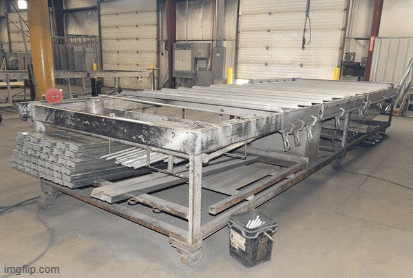How Double D Trailers Are Built — Step-by-Step from Weld to Finish
See why riders trust us from the first weld to final delivery.
Your Custom Trailer Journey: Transparency in Craftsmanship
Choosing a horse trailer is about more than specs — it’s about trust. At Double D Trailers, we handcraft each trailer with an obsessive focus on safety, innovation, and the unique needs of your horse. This guide walks you through our manufacturing process step by step, showing exactly how our trailers are built and why it matters. But don’t just take our word for it. See it for yourself.

Smart Design You Can See in Action
No hidden factory lines. No shortcuts. This quick behind-the-scenes look shows what makes Double D Trailers different — thoughtful welds, premium materials, and safety-first design brought to life by expert hands.
Step 1: Laying the Foundation — The Z-Frame Chassis
Every Double D Trailer starts with our Z-Frame® chassis:
- Engineered Strength: The unique Z-shape offers a superior strength-to-weight ratio compared to traditional C-channel frames.
- Corrosion Resistance: Zinc and chromate impregnation protect the frame from rust.
- Structural Support: 16-inch on-center cross-members provide excellent floor support.
“Using precise jig fixtures and adhering to stringent welding standards ensures the structural integrity of every Z-Frame chassis we build.”
— Double D Trailers Head Welder
Step 2: Framing the Structure — Walls and Support
- Full Z-Frame Structure: Uprights and walls use the same strong Z-Frame for unified strength.
- Ergonomic Raised Dressing Room Floor: Integrated during the framing process for easier access and maintenance.
- Secure Coupler Integration: The tongue and coupler are structurally joined to the main chassis.
Step 3: Installing Key Internal Components
- Rumber Flooring: Recycled rubber boards provide superior durability and eliminate the need for floor mats.
- SafeKick® Wall Prep: Reinforced wall lower halves protect horses from injury.
- SafeTack® Swing-Out Tack: A rear tack design that improves loading safety.
- Tubular Dividers: Enhance airflow and reduce risk of horses getting cast.
Step 4: Enclosing the Trailer — Skin, Ramps, and Roof
- Two-Layer Wall System: Provides insulation and structural reinforcement.
- Galvalite Interior Walls: Corrosion-resistant and easy to clean.
- Reverse Load Option: Side ramps offer alternative loading options for nervous horses.
- SafeBump® Roof: Seamless fiber composite that protects from overhead injuries and prevents leaks.
Step 5: Exterior Finishing — Bonding, Paint & Protection
- 3M Chemical Bonding System: Bonds skin to frame without rivets or screws, preventing leaks.
- Epoxy Primer + Multi-Coat Paint: A long-lasting finish that resists corrosion.
- Clean Lines: No external fasteners means a sleek, stress-free exterior.
Step 6: Final Touches and Systems Integration
- Drop-Down Windows: Provide ventilation and are gasket-sealed to prevent leaks.
- Integrated Lighting and Running Boards: Enhance function and ease of use.
- Locking System: Single-key convenience for all access points.
- Final QA Inspection: Every trailer is thoroughly tested before delivery.
Solving Real Problems with Smarter Design
Our trailers are engineered to solve the most common trailer issues:
- Rust: Z-Frame + Galvalite = high corrosion resistance.
- Floor Rot: Rumber flooring eliminates moisture issues.
- Flexing Frames: Z-Frame maintains structural integrity over time.
- Leaks: 3M bonding eliminates gaps that rivets or screws can cause.
- Poor Ventilation: Insulated walls and thoughtful airflow design reduce heat stress.
- Horse Injury: Features like SafeKick® walls and SafeBump® roof minimize injury risk.
Happy Customers, Real Experiences
"The quality of construction is outstanding, and you can tell they really prioritize the safety and comfort of the horses." — Kristin H.
"Absolutely love my Double D Trailer! The design is so well thought out for the horses' safety and ease of use for me." — Jennifer H.
Read more Double D Trailers customer reviews
Frequently Asked Questions
Frequently Asked Questions
What is Z-Frame construction?
Z-Frame tubes are made from a steel base infused with zinc and chromate, which combine to resist rust and minimize heat transfer. These tubes are formed into a unique Z-shape to provide superior strength without excess weight.
How is the trailer skin attached to the frame?
We use a 3M chemical bonding system instead of rivets or screws. This creates a cleaner look and a stronger, leak-proof connection.
Why choose Rumber flooring over wood?
Rumber is made from recycled rubber, resists moisture and rot, reduces vibration, and is easier to clean than traditional flooring with mats.
How does SafeTack improve loading safety?
The swing-out rear tack removes the tunnel-like design of traditional trailers, giving horses a more open and less intimidating loading experience.
Is there a reverse load option?
Yes! Our reverse load models use side ramps that allow horses to walk on and off the trailer in a more natural, forward-facing direction.
What warranty do you offer?
Every Double D Trailer comes with a comprehensive warranty, and delivered by trained professionals who understand the value of careful, on-time service. Every trailer leaves our facility fully inspected and ready for the road.
Can I customize my trailer?
Absolutely. Each trailer is built to order based on your exact needs — from layout to color to features.

